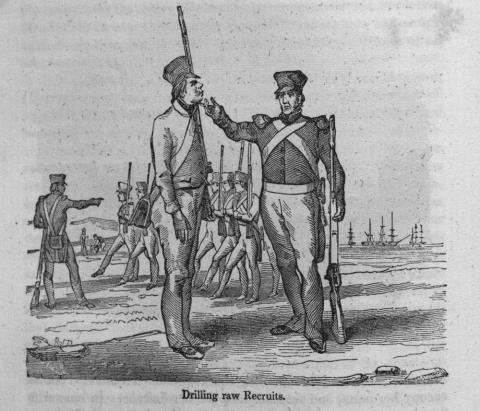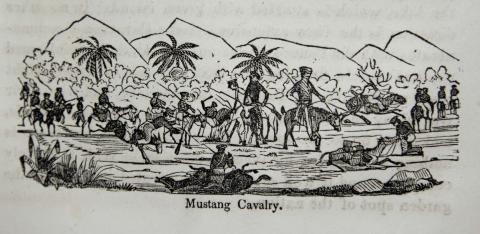Biographies | Essays | Broadsides | Correspondence | Music & Poetry | Newspapers | Images | Maps | Speeches & Orations
When the United States declared war against Mexico in May 1846, it was ill-prepared to undertake a major campaign beyond its borders. The regular army consisted of less than 10,000 men, most of them scattered along the western frontier in small units without experience in large scale operations. Few officers and enlisted men had ever trained in regimental and brigade-sized formations, which would be required during the war with Mexico (see the U.S. on the Eve of War with Mexico).
To supplement the regular army, the war bill passed by Congress authorized the call-up of fifty thousand volunteers, to be raised by the state militias for a twelve-month period. The War Department issued the call to the following states: Alabama, Kentucky, Illinois, Indiana, Ohio, Mississippi, and Tennessee. The bill also empowered Congress to increase the strength of the regular army to roughly 20,000, raising the number of privates in a company to one hundred, and creating an engineer company and a new regiment, the U.S. Mounted Rifles.
The administration's call for volunteers was greeted with a burst of patriotic enthusiasm; by some estimates, more than 200,000 men sought to enlist. In Tennessee the selection had to be made by lottery, while the quotas of some states were filled so quickly that young men moved to neighboring states to volunteer.
Although the outbreak of hostilities along the Rio Grande provoked a surge of martial pride, a spirit of bipartisanship was noticeably lacking as the nation prepared for war. The war bill required President Polk to appoint dozens of brigade and division commanders, posts that were eagerly sought by Democratic political leaders. In addition, by doubling the size of the regular army to roughly 20,000, Congress created a new command structure with hundreds of new officers' commissions, as well as a greatly expanded War Department staff for logistical and support roles-positions that would all be filled by the Democratic commander-in-chief (see Partisanship and the U.S. War Effort).


